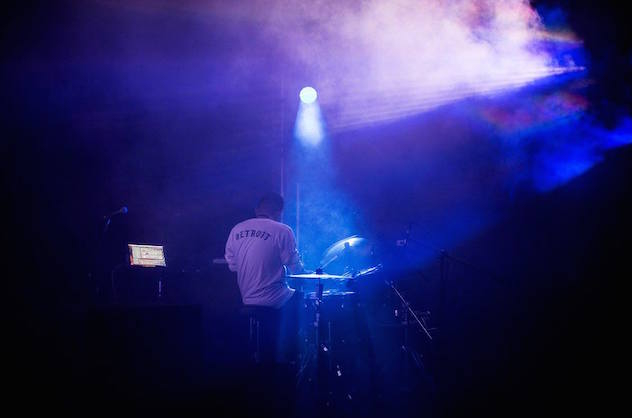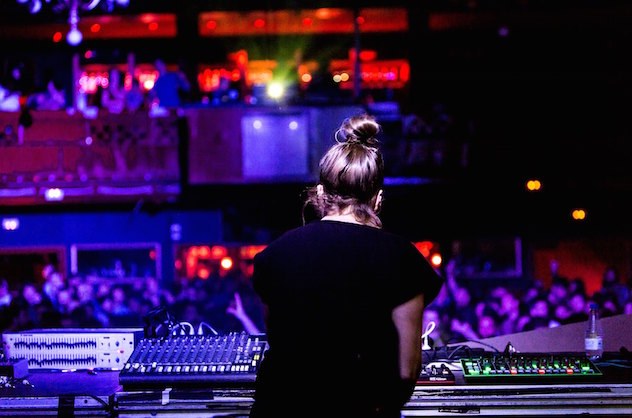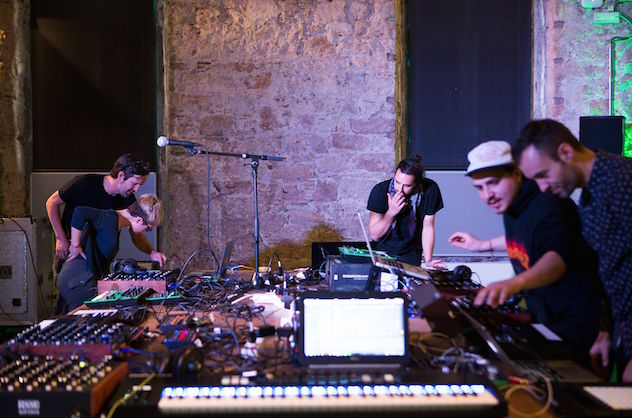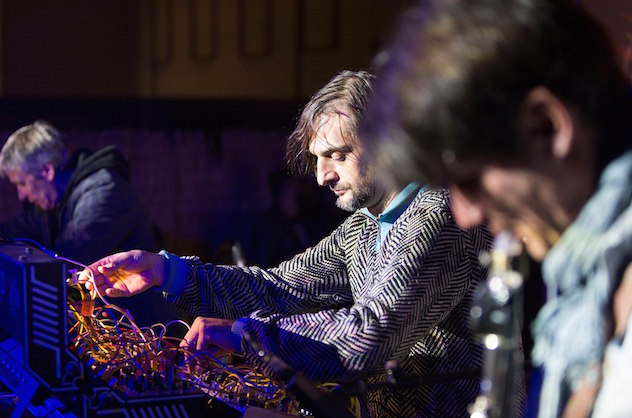- Barcelona is a beautiful city, a lovely place to visit and a place where people definitely like to party, but the state of its club scene can be downright disheartening. Punters who pass through during Sónar might go home with sparkling memories of packed dance floors and stacked lineups, but the other 51 weeks of the year are far less satisfying. Like many major hubs these days, the city suffers from a lack of good venues and most promoters are content to simply capitalize on the hordes of tourists who roam the streets in search of the nearest fiesta.
It's impressive, then, that a festival like MUTEK.ES has managed to take root. Designed as a convergence of electronic music and cutting-edge technology, MUTEK has been slowly growing in Barcelona, with this year its seventh in Spain. In truth, the festival isn't on the same level as its original event in Montreal or its long-running Mexico City edition, but its organizers deserve credit for pushing ahead and making a relatively niche event like this work.
 MUTEK.ES took place over four nights at venues across the city. The bulk of the activity was concentrated on Friday and Saturday, with afternoon and evening sessions at the Fabrica Estrella Damm—an old beer factory that's been converted into a cultural space—and nighttime events at Nitsa/Apolo, one of the city's well-trodden dance floors.
Those late-night parties were MUTEK's biggest attraction, as Nitsa's main room played host to crowd-pleasing acts like Gerd Janson, AtomTM & Tobias, Rrose and Henrik Schwarz (who was joined on stage by Bugge Wesseltoft). Steffi's hard-charging, electro-tinged live set on Saturday night was a real highlight, as was Friday's disarmingly deep session from Reagenz, AKA Move D and Jonah Sharp. Nitsa also played host to much of the festival's local contingent. The second room downstairs featured live sets from acts like Sunny Graves, Cauto, BSN Posse, The Suicide Of Western Culture and Hivern Discs affiliate JMII, who was arguably the best of the bunch, especially during his set's more melodic, Balearic moments.
MUTEK.ES took place over four nights at venues across the city. The bulk of the activity was concentrated on Friday and Saturday, with afternoon and evening sessions at the Fabrica Estrella Damm—an old beer factory that's been converted into a cultural space—and nighttime events at Nitsa/Apolo, one of the city's well-trodden dance floors.
Those late-night parties were MUTEK's biggest attraction, as Nitsa's main room played host to crowd-pleasing acts like Gerd Janson, AtomTM & Tobias, Rrose and Henrik Schwarz (who was joined on stage by Bugge Wesseltoft). Steffi's hard-charging, electro-tinged live set on Saturday night was a real highlight, as was Friday's disarmingly deep session from Reagenz, AKA Move D and Jonah Sharp. Nitsa also played host to much of the festival's local contingent. The second room downstairs featured live sets from acts like Sunny Graves, Cauto, BSN Posse, The Suicide Of Western Culture and Hivern Discs affiliate JMII, who was arguably the best of the bunch, especially during his set's more melodic, Balearic moments.
 On both Friday and Saturday night, Nitsa was packed, luring a crowd that extended well beyond the city's usual assortment of tourists and college students. Clearly, MUTEK.ES is the sort of event that can convince retired clubbers and armchair enthusiasts to venture back onto the floor, if only for night or two, and their presence helped create an upbeat atmosphere where music felt like the focus rather than an afterthought.
Bespoke visuals and stage production also helped buoy the vibe. On a regular night, Nitsa's main room isn't bad—it's a lovely old theater that's still an excellent place to see bands—but as a club, it often seems a bit drab, with just a makeshift DJ booth plunked onto the stage. What MUTEK.ES did was by no means revolutionary—they simply added some stage builds and projected visuals onto them—but the room felt noticeably bigger, more vibrant, and, most importantly, different. In a venue that many Barcelona residents have been to dozens of times, a little change goes a long way.
On both Friday and Saturday night, Nitsa was packed, luring a crowd that extended well beyond the city's usual assortment of tourists and college students. Clearly, MUTEK.ES is the sort of event that can convince retired clubbers and armchair enthusiasts to venture back onto the floor, if only for night or two, and their presence helped create an upbeat atmosphere where music felt like the focus rather than an afterthought.
Bespoke visuals and stage production also helped buoy the vibe. On a regular night, Nitsa's main room isn't bad—it's a lovely old theater that's still an excellent place to see bands—but as a club, it often seems a bit drab, with just a makeshift DJ booth plunked onto the stage. What MUTEK.ES did was by no means revolutionary—they simply added some stage builds and projected visuals onto them—but the room felt noticeably bigger, more vibrant, and, most importantly, different. In a venue that many Barcelona residents have been to dozens of times, a little change goes a long way.
 The Fabrica Estrella Damm—a place that usually has nothing to do with clubbing—also made for a different kind of going out experience. One of the stages was set up below a large parking overhang, hosting sets from artists like Pole, The Orb, Valentin Stip and Vilod, AKA Max Loderbauer and Ricardo Villalobos. Although the sound wasn't great and some of these performances were a bit dull, there was one act that did shine: Shigeto. Perched behind a drum kit, the Detroit native pounded away as rich melodies flooded in, his arresting visuals complementing what was a mesmerizing listen.
More standout performances took place inside the Fabrica's Maquinas room, where local outifit Intorno Labs had installed an elaborate 3D soundsystem, allowing artists to expand their efforts well beyond the usual two-channel possibilities of stereo. Of all the acts to perform in the space, Deadbeat pulled in the biggest crowd, but sets from Montreal experimenter Kara-Lis Coverdale and Italian producer Vaghe Stelle were ultimately more impressive. Both acts dove headlong into the possibilities of a 3D system, the former crafting a swirling maelstrom of alternately serene and discordant sound while the latter explored various corners of the bass continuum.
The Fabrica Estrella Damm—a place that usually has nothing to do with clubbing—also made for a different kind of going out experience. One of the stages was set up below a large parking overhang, hosting sets from artists like Pole, The Orb, Valentin Stip and Vilod, AKA Max Loderbauer and Ricardo Villalobos. Although the sound wasn't great and some of these performances were a bit dull, there was one act that did shine: Shigeto. Perched behind a drum kit, the Detroit native pounded away as rich melodies flooded in, his arresting visuals complementing what was a mesmerizing listen.
More standout performances took place inside the Fabrica's Maquinas room, where local outifit Intorno Labs had installed an elaborate 3D soundsystem, allowing artists to expand their efforts well beyond the usual two-channel possibilities of stereo. Of all the acts to perform in the space, Deadbeat pulled in the biggest crowd, but sets from Montreal experimenter Kara-Lis Coverdale and Italian producer Vaghe Stelle were ultimately more impressive. Both acts dove headlong into the possibilities of a 3D system, the former crafting a swirling maelstrom of alternately serene and discordant sound while the latter explored various corners of the bass continuum.
 That said, MUTEK.ES didn't always fire on all cylinders. The festival's first two nights were something of a letdown. Billed as A/Visions, a series of audio-visual events that are a staple of any MUTEK event, they largely failed to deliver on the latter half of the equation. For instance, while Thursday's collaborative jam session between Henrik Schwarz, Bugge Wesseltoft and Dan Berglund won rave reviews from the crowd—at least from those who enjoy chin-stroking jazz-electronic hybrids—it didn't actually feature any visuals. Other acts did get into the spirit, but their efforts weren't particularly compelling: Edu Comelles played along to a fixed shot of a vibrating glass of water, while Afloat, Thursday evening's opener, relied on an underwhelming series of serene, oceanic video footage. Of the entire A/Visions roster, only French pair Franck Vigroux and Kurt D'Haeseleer really made a strong visual impression, their constantly morphing array of goblin-like figures pairing well with their static-laden soundscapes.
MUTEK.ES has a bit more growing to do, both in terms of programming and execution. Nevertheless, the festival was still an enjoyable experience and absolutely the sort of thing that Barcelona's music scene needs. In a city where the clubbing landscape is generally uninspired, promoters with an eye toward something a bit more leftfield are facing an uphill battle, to say the least. The MUTEK.ES organizers know this, yet the festival continues to forge ahead, gradually picking up steam with each edition. They're building for the future, and that's something to be celebrated.
That said, MUTEK.ES didn't always fire on all cylinders. The festival's first two nights were something of a letdown. Billed as A/Visions, a series of audio-visual events that are a staple of any MUTEK event, they largely failed to deliver on the latter half of the equation. For instance, while Thursday's collaborative jam session between Henrik Schwarz, Bugge Wesseltoft and Dan Berglund won rave reviews from the crowd—at least from those who enjoy chin-stroking jazz-electronic hybrids—it didn't actually feature any visuals. Other acts did get into the spirit, but their efforts weren't particularly compelling: Edu Comelles played along to a fixed shot of a vibrating glass of water, while Afloat, Thursday evening's opener, relied on an underwhelming series of serene, oceanic video footage. Of the entire A/Visions roster, only French pair Franck Vigroux and Kurt D'Haeseleer really made a strong visual impression, their constantly morphing array of goblin-like figures pairing well with their static-laden soundscapes.
MUTEK.ES has a bit more growing to do, both in terms of programming and execution. Nevertheless, the festival was still an enjoyable experience and absolutely the sort of thing that Barcelona's music scene needs. In a city where the clubbing landscape is generally uninspired, promoters with an eye toward something a bit more leftfield are facing an uphill battle, to say the least. The MUTEK.ES organizers know this, yet the festival continues to forge ahead, gradually picking up steam with each edition. They're building for the future, and that's something to be celebrated.
 Photo credit /
Alba Rupérez
Photo credit /
Alba Rupérez
 MUTEK.ES took place over four nights at venues across the city. The bulk of the activity was concentrated on Friday and Saturday, with afternoon and evening sessions at the Fabrica Estrella Damm—an old beer factory that's been converted into a cultural space—and nighttime events at Nitsa/Apolo, one of the city's well-trodden dance floors.
Those late-night parties were MUTEK's biggest attraction, as Nitsa's main room played host to crowd-pleasing acts like Gerd Janson, AtomTM & Tobias, Rrose and Henrik Schwarz (who was joined on stage by Bugge Wesseltoft). Steffi's hard-charging, electro-tinged live set on Saturday night was a real highlight, as was Friday's disarmingly deep session from Reagenz, AKA Move D and Jonah Sharp. Nitsa also played host to much of the festival's local contingent. The second room downstairs featured live sets from acts like Sunny Graves, Cauto, BSN Posse, The Suicide Of Western Culture and Hivern Discs affiliate JMII, who was arguably the best of the bunch, especially during his set's more melodic, Balearic moments.
MUTEK.ES took place over four nights at venues across the city. The bulk of the activity was concentrated on Friday and Saturday, with afternoon and evening sessions at the Fabrica Estrella Damm—an old beer factory that's been converted into a cultural space—and nighttime events at Nitsa/Apolo, one of the city's well-trodden dance floors.
Those late-night parties were MUTEK's biggest attraction, as Nitsa's main room played host to crowd-pleasing acts like Gerd Janson, AtomTM & Tobias, Rrose and Henrik Schwarz (who was joined on stage by Bugge Wesseltoft). Steffi's hard-charging, electro-tinged live set on Saturday night was a real highlight, as was Friday's disarmingly deep session from Reagenz, AKA Move D and Jonah Sharp. Nitsa also played host to much of the festival's local contingent. The second room downstairs featured live sets from acts like Sunny Graves, Cauto, BSN Posse, The Suicide Of Western Culture and Hivern Discs affiliate JMII, who was arguably the best of the bunch, especially during his set's more melodic, Balearic moments.
 On both Friday and Saturday night, Nitsa was packed, luring a crowd that extended well beyond the city's usual assortment of tourists and college students. Clearly, MUTEK.ES is the sort of event that can convince retired clubbers and armchair enthusiasts to venture back onto the floor, if only for night or two, and their presence helped create an upbeat atmosphere where music felt like the focus rather than an afterthought.
Bespoke visuals and stage production also helped buoy the vibe. On a regular night, Nitsa's main room isn't bad—it's a lovely old theater that's still an excellent place to see bands—but as a club, it often seems a bit drab, with just a makeshift DJ booth plunked onto the stage. What MUTEK.ES did was by no means revolutionary—they simply added some stage builds and projected visuals onto them—but the room felt noticeably bigger, more vibrant, and, most importantly, different. In a venue that many Barcelona residents have been to dozens of times, a little change goes a long way.
On both Friday and Saturday night, Nitsa was packed, luring a crowd that extended well beyond the city's usual assortment of tourists and college students. Clearly, MUTEK.ES is the sort of event that can convince retired clubbers and armchair enthusiasts to venture back onto the floor, if only for night or two, and their presence helped create an upbeat atmosphere where music felt like the focus rather than an afterthought.
Bespoke visuals and stage production also helped buoy the vibe. On a regular night, Nitsa's main room isn't bad—it's a lovely old theater that's still an excellent place to see bands—but as a club, it often seems a bit drab, with just a makeshift DJ booth plunked onto the stage. What MUTEK.ES did was by no means revolutionary—they simply added some stage builds and projected visuals onto them—but the room felt noticeably bigger, more vibrant, and, most importantly, different. In a venue that many Barcelona residents have been to dozens of times, a little change goes a long way.
 The Fabrica Estrella Damm—a place that usually has nothing to do with clubbing—also made for a different kind of going out experience. One of the stages was set up below a large parking overhang, hosting sets from artists like Pole, The Orb, Valentin Stip and Vilod, AKA Max Loderbauer and Ricardo Villalobos. Although the sound wasn't great and some of these performances were a bit dull, there was one act that did shine: Shigeto. Perched behind a drum kit, the Detroit native pounded away as rich melodies flooded in, his arresting visuals complementing what was a mesmerizing listen.
More standout performances took place inside the Fabrica's Maquinas room, where local outifit Intorno Labs had installed an elaborate 3D soundsystem, allowing artists to expand their efforts well beyond the usual two-channel possibilities of stereo. Of all the acts to perform in the space, Deadbeat pulled in the biggest crowd, but sets from Montreal experimenter Kara-Lis Coverdale and Italian producer Vaghe Stelle were ultimately more impressive. Both acts dove headlong into the possibilities of a 3D system, the former crafting a swirling maelstrom of alternately serene and discordant sound while the latter explored various corners of the bass continuum.
The Fabrica Estrella Damm—a place that usually has nothing to do with clubbing—also made for a different kind of going out experience. One of the stages was set up below a large parking overhang, hosting sets from artists like Pole, The Orb, Valentin Stip and Vilod, AKA Max Loderbauer and Ricardo Villalobos. Although the sound wasn't great and some of these performances were a bit dull, there was one act that did shine: Shigeto. Perched behind a drum kit, the Detroit native pounded away as rich melodies flooded in, his arresting visuals complementing what was a mesmerizing listen.
More standout performances took place inside the Fabrica's Maquinas room, where local outifit Intorno Labs had installed an elaborate 3D soundsystem, allowing artists to expand their efforts well beyond the usual two-channel possibilities of stereo. Of all the acts to perform in the space, Deadbeat pulled in the biggest crowd, but sets from Montreal experimenter Kara-Lis Coverdale and Italian producer Vaghe Stelle were ultimately more impressive. Both acts dove headlong into the possibilities of a 3D system, the former crafting a swirling maelstrom of alternately serene and discordant sound while the latter explored various corners of the bass continuum.
 That said, MUTEK.ES didn't always fire on all cylinders. The festival's first two nights were something of a letdown. Billed as A/Visions, a series of audio-visual events that are a staple of any MUTEK event, they largely failed to deliver on the latter half of the equation. For instance, while Thursday's collaborative jam session between Henrik Schwarz, Bugge Wesseltoft and Dan Berglund won rave reviews from the crowd—at least from those who enjoy chin-stroking jazz-electronic hybrids—it didn't actually feature any visuals. Other acts did get into the spirit, but their efforts weren't particularly compelling: Edu Comelles played along to a fixed shot of a vibrating glass of water, while Afloat, Thursday evening's opener, relied on an underwhelming series of serene, oceanic video footage. Of the entire A/Visions roster, only French pair Franck Vigroux and Kurt D'Haeseleer really made a strong visual impression, their constantly morphing array of goblin-like figures pairing well with their static-laden soundscapes.
MUTEK.ES has a bit more growing to do, both in terms of programming and execution. Nevertheless, the festival was still an enjoyable experience and absolutely the sort of thing that Barcelona's music scene needs. In a city where the clubbing landscape is generally uninspired, promoters with an eye toward something a bit more leftfield are facing an uphill battle, to say the least. The MUTEK.ES organizers know this, yet the festival continues to forge ahead, gradually picking up steam with each edition. They're building for the future, and that's something to be celebrated.
That said, MUTEK.ES didn't always fire on all cylinders. The festival's first two nights were something of a letdown. Billed as A/Visions, a series of audio-visual events that are a staple of any MUTEK event, they largely failed to deliver on the latter half of the equation. For instance, while Thursday's collaborative jam session between Henrik Schwarz, Bugge Wesseltoft and Dan Berglund won rave reviews from the crowd—at least from those who enjoy chin-stroking jazz-electronic hybrids—it didn't actually feature any visuals. Other acts did get into the spirit, but their efforts weren't particularly compelling: Edu Comelles played along to a fixed shot of a vibrating glass of water, while Afloat, Thursday evening's opener, relied on an underwhelming series of serene, oceanic video footage. Of the entire A/Visions roster, only French pair Franck Vigroux and Kurt D'Haeseleer really made a strong visual impression, their constantly morphing array of goblin-like figures pairing well with their static-laden soundscapes.
MUTEK.ES has a bit more growing to do, both in terms of programming and execution. Nevertheless, the festival was still an enjoyable experience and absolutely the sort of thing that Barcelona's music scene needs. In a city where the clubbing landscape is generally uninspired, promoters with an eye toward something a bit more leftfield are facing an uphill battle, to say the least. The MUTEK.ES organizers know this, yet the festival continues to forge ahead, gradually picking up steam with each edition. They're building for the future, and that's something to be celebrated.
 Photo credit /
Alba Rupérez
Photo credit /
Alba Rupérez